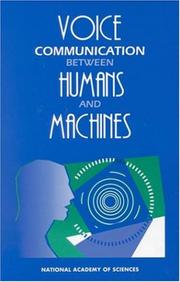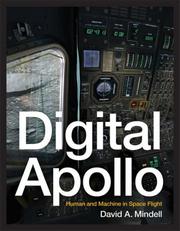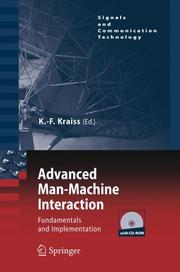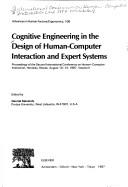| Listing 1 - 7 of 7 |
Sort by
|
Book
ISBN: 2913372414 9782913372412 Year: 2004 Publisher: Paris La fabrique éditions
Abstract | Keywords | Export | Availability | Bookmark
 Loading...
Loading...Choose an application
- Reference Manager
- EndNote
- RefWorks (Direct export to RefWorks)
Methods engineering --- Industrial sociology --- Human-machine systems --- Organisation du travail --- Sociologie industrielle --- Systèmes homme-machine --- History --- Histoire --- 331 --- 301 --- arbeid --- sociologie --- CDL --- 130.2

ISBN: 0309049881 9786610195909 1280195908 0309556252 0585001812 9780585001814 9780309049887 9781280195907 6610195900 9780309556255 Year: 1994 Publisher: Washington, D.C. National Academy Press
Abstract | Keywords | Export | Availability | Bookmark
 Loading...
Loading...Choose an application
- Reference Manager
- EndNote
- RefWorks (Direct export to RefWorks)
Automatic speech recognition. --- Human-machine systems. --- Reconnaissance automatique de la parole --- Systèmes homme-machine --- Human-machine systems --- Automatic speech recognition --- Electrical Engineering --- Electrical & Computer Engineering --- Engineering & Applied Sciences --- Human operators (Systems engineering) --- Human subsystems (Systems engineering) --- Man-machine control systems --- Man-machine systems --- Operator-machine systems --- Engineering systems --- Human engineering --- Mechanical speech recognizer --- Speech recognition, Automatic --- Pattern recognition systems --- Perceptrons --- Speech, Intelligibility of --- Speech perception --- Speech processing systems --- Systèmes homme-machine

ISBN: 0262266679 1435643291 9780262266673 9781435643291 9780262266680 0262266687 0262134977 9780262134972 9780262516105 Year: 2008 Publisher: Cambridge, MA MIT Press
Abstract | Keywords | Export | Availability | Bookmark
 Loading...
Loading...Choose an application
- Reference Manager
- EndNote
- RefWorks (Direct export to RefWorks)
How human pilots and automated systems worked together to achieve the ultimate in flight--the lunar landings of NASA's Apollo program.As Apollo 11's Lunar Module descended toward the moon under automatic control, a program alarm in the guidance computer's software nearly caused a mission abort. Neil Armstrong responded by switching off the automatic mode and taking direct control. He stopped monitoring the computer and began flying the spacecraft, relying on skill to land it and earning praise for a triumph of human over machine. In Digital Apollo, engineer-historian David Mindell takes this famous moment as a starting point for an exploration of the relationship between humans and computers in the Apollo program. In each of the six Apollo landings, the astronaut in command seized control from the computer and landed with his hand on the stick. Mindell recounts the story of astronauts' desire to control their spacecraft in parallel with the history of the Apollo Guidance Computer. From the early days of aviation through the birth of spaceflight, test pilots and astronauts sought to be more than "spam in a can" despite the automatic controls, digital computers, and software developed by engineers.Digital Apollo examines the design and execution of each of the six Apollo moon landings, drawing on transcripts and data telemetry from the flights, astronaut interviews, and NASA's extensive archives. Mindell's exploration of how human pilots and automated systems worked together to achieve the ultimate in flight--a lunar landing--traces and reframes the debate over the future of humans and automation in space. The results have implications for any venture in which human roles seem threatened by automated systems, whether it is the work at our desktops or the future of exploration.
Human-machine systems. --- Astronautics --- Manned space flight --- History. --- Project Apollo (U.S.) --- Human operators (Systems engineering) --- Human subsystems (Systems engineering) --- Man-machine control systems --- Man-machine systems --- Operator-machine systems --- Apollo Project (U.S.) --- United States. --- Progetto Apollo (U.S.) --- Engineering systems --- Human engineering --- SCIENCE, TECHNOLOGY & SOCIETY/General --- PHYSICAL SCIENCES/General --- COMPUTER SCIENCE/Human Computer Interaction --- Human-machine systems --- Systèmes homme-machine --- Astronautique --- History --- Histoire

ISBN: 0262524317 0262025108 0262255839 0585446504 9780262255837 9780585446509 9780262524315 9780262025102 Year: 2002 Publisher: Cambridge, Massachusetts [Piscataqay, New Jersey] MIT Press IEEE Xplore
Abstract | Keywords | Export | Availability | Bookmark
 Loading...
Loading...Choose an application
- Reference Manager
- EndNote
- RefWorks (Direct export to RefWorks)
Cynthia Breazeal here presents her vision of the sociable robot of the future, a synthetic creature and not merely a sophisticated tool. A sociable robot will be able to understand us, to communicate and interact with us, to learn from us and grow with us. It will be socially intelligent in a humanlike way. Eventually sociable robots will assist us in our daily lives, as collaborators and companions. Because the most successful sociable robots will share our social characteristics, the effort to make sociable robots is also a means for exploring human social intelligence and even what it means to be human. Breazeal defines the key components of social intelligence for these machines and offers a framework and set of design issues for their realization. Much of the book focuses on a nascent sociable robot she designed named Kismet. Breazeal offers a concrete implementation for Kismet, incorporating insights from the scientific study of animals and people, as well as from artistic disciplines such as classical animation. This blending of science, engineering, and art creates a lifelike quality that encourages people to treat Kismet as a social creature rather than just a machine. The book includes a CD-ROM that shows Kismet in action.
Human-machine systems. --- Artificial intelligence. --- Systèmes homme-machine --- Intelligence artificielle --- Robots --- Design and construction. --- Systèmes homme-machine --- Human operators (Systems engineering) --- Human subsystems (Systems engineering) --- Man-machine control systems --- Man-machine systems --- Operator-machine systems --- AI (Artificial intelligence) --- Artificial thinking --- Electronic brains --- Intellectronics --- Intelligence, Artificial --- Intelligent machines --- Machine intelligence --- Thinking, Artificial --- Automata --- Automatons --- Engineering systems --- Human engineering --- Bionics --- Cognitive science --- Digital computer simulation --- Electronic data processing --- Logic machines --- Machine theory --- Self-organizing systems --- Simulation methods --- Fifth generation computers --- Neural computers --- Manipulators (Mechanism) --- Robotics --- Mecha (Vehicles) --- Human-machine systems --- Artificial intelligence --- Design and construction --- E-books --- COMPUTER SCIENCE/Robotics & Agents

ISBN: 082645903X 0826459021 9780826459022 9780826459039 9781847144393 184714439X 1472545877 9781472545879 1281291994 9781281291998 9786611291990 6611291997 9781441160768 1441160760 Year: 2002 Publisher: London Continuum
Abstract | Keywords | Export | Availability | Bookmark
 Loading...
Loading...Choose an application
- Reference Manager
- EndNote
- RefWorks (Direct export to RefWorks)
The Cyborg Experiments analyzes the challenges posed to corporeality by techology. Taking as their starting point the work of the highly influential performance artists Orlan and Stelarc, the essays in this timely and important collection raise a number of questions in relation to new conceptions of embodiment, identity and otherness in the age of new technologies: Has the body become obsolete? Does transgender challenge traditional ideas of agency? Have we always been cyborgs?In addition to highlighting the playful character of digital aesthetics, the contributors investigate ethical issues concerning the ownership of our bodies and the experiments we perform on them. In this way the book explores how humanism, and ideas of "the human", have been placed under increasing scrutiny as a result of new developments in science, media and communications.Contributors:John Appleby, Rachel Armstrong, Fred Botting, Julie Clarke, Gary Hall, Chris Hables Gray, Meredith Jones, Orlan, Mark Poster, Jay Prosser, E. A. Scheer, Zod Sofia, Stelarc, Scott Wilson, Joanna Zylinska
Body Art mutilaties transformaties The Cyborg Experiments --- Orlan --- Stelarc --- Kunsttheorie 21ste eeuw --- 7.01 --- Kunst theorie, filosofie, esthetica --- Cyborgs --- Human-machine systems --- Robotics --- Body Art ; mutilaties ; transformaties ; The Cyborg Experiments --- Kunsttheorie ; 21ste eeuw --- Automation --- Machine theory --- Human operators (Systems engineering) --- Human subsystems (Systems engineering) --- Man-machine control systems --- Man-machine systems --- Operator-machine systems --- Engineering systems --- Human engineering --- Cybernetic organisms --- Persons --- Social aspects --- Kunst ; theorie, filosofie, esthetica --- Artificial intelligence. Robotics. Simulation. Graphics --- Sociology of culture --- Systèmes homme-machine --- Robotique --- Aspect social --- Social aspects. --- Human-machine systems. --- Cyborgs. --- Robotics - Social aspects

ISBN: 9783540306184 3540306188 3642445640 3540306196 Year: 2006 Publisher: Berlin ; New York : Springer,
Abstract | Keywords | Export | Availability | Bookmark
 Loading...
Loading...Choose an application
- Reference Manager
- EndNote
- RefWorks (Direct export to RefWorks)
Man-machine interaction is the gateway providing access to functions and services, which, due to the ever increasing complexity of smart systems, threatens to become a bottleneck. This book therefore introduces not only advanced interfacing concepts, but also gives insight into the related theoretical background.This refers mainly to the realization of video-based multimodal interaction via gesture, mimics, and speech, but also to interacting with virtual object in virtual environments, cooperating with local or remote robots, and user assistance. While most publications in the field of human factors engineering focus on interface design, this book puts special emphasis on implementation aspects. To this end it is accompanied by software development environments for image processing, classification, and virtual environment implementation. In addition a test data base is included for gestures, head pose, facial expressions, full-body person recognition, and people tracking. These data are used for the examples throughout the book, but are also meant to encourage the reader to start experimentation on his own. Thus the book may serve as a self-contained introduction both for researchers and developers of man-machine interfaces. It may also be used for graduate-level university courses.
Human-machine systems. --- Systèmes homme-machine --- Human engineering. --- Human-computer interaction. --- Human-machine systems --- Human-computer interaction --- Human engineering --- Systèmes homme-machine --- EPUB-LIV-FT LIVINGEN SPRINGER-B --- Ergonomics --- Human factors in engineering design --- Computer-human interaction --- Human factors in computing systems --- Interaction, Human-computer --- Human operators (Systems engineering) --- Human subsystems (Systems engineering) --- Man-machine control systems --- Man-machine systems --- Operator-machine systems --- Engineering. --- Rehabilitation. --- User interfaces (Computer systems). --- Computer graphics. --- Engineering design. --- Control engineering. --- Robotics. --- Mechatronics. --- Control, Robotics, Mechatronics. --- Signal, Image and Speech Processing. --- User Interfaces and Human Computer Interaction. --- Computer Imaging, Vision, Pattern Recognition and Graphics. --- Engineering Design. --- Mechanical engineering --- Microelectronics --- Microelectromechanical systems --- Automation --- Machine theory --- Control engineering --- Control equipment --- Control theory --- Engineering instruments --- Programmable controllers --- Design, Engineering --- Engineering --- Industrial design --- Strains and stresses --- Automatic drafting --- Graphic data processing --- Graphics, Computer --- Computer art --- Graphic arts --- Electronic data processing --- Engineering graphics --- Image processing --- Interfaces, User (Computer systems) --- Construction --- Industrial arts --- Technology --- Design --- Digital techniques --- Bioengineering --- Environmental engineering --- Industrial engineering --- Human comfort --- Human-robot interaction --- User-centered system design --- User interfaces (Computer systems) --- Engineering systems --- Computer science. --- Computer vision. --- Machine vision --- Vision, Computer --- Artificial intelligence --- Pattern recognition systems --- Informatics --- Science --- Signal processing. --- Image processing. --- Speech processing systems. --- Optical data processing. --- Optical computing --- Visual data processing --- Bionics --- Integrated optics --- Photonics --- Computers --- Computational linguistics --- Electronic systems --- Information theory --- Modulation theory --- Oral communication --- Speech --- Telecommunication --- Singing voice synthesizers --- Pictorial data processing --- Picture processing --- Processing, Image --- Imaging systems --- Optical data processing --- Processing, Signal --- Information measurement --- Signal theory (Telecommunication) --- Optical equipment

ISBN: 0444423966 0444427279 1322471789 1483297276 9780444427274 9781483297279 9780444423962 Year: 1987 Volume: 7 Publisher: Amsterdam Elsevier
Abstract | Keywords | Export | Availability | Bookmark
 Loading...
Loading...Choose an application
- Reference Manager
- EndNote
- RefWorks (Direct export to RefWorks)
The objectives of Human Reliability are to build reliability into the job, into the machine, and into the environment, and to let man perform naturally. In this book the author shows how these objectives can be achieved by concentrating on human reliability issues during the design stage. This is done by illustrating the relationships between various design features and some aspect of human performance, e.g. human errors.The book is designed as a practical guide to the daily performance of tasks in Human Reliability as well as a general reference and tutorial introduction to the field. It i
Man-Machine Systems --- Systems Analysis --- Man-Machine Systems. --- Systems Analysis. --- Agent-Based Modeling --- Analysis, Systems --- Complexity Analysis --- System Dynamics Analysis --- Systems Approach --- Systems Medicine --- Systems Oriented Approach --- Systems Thinking --- Agent Based Modeling --- Agent-Based Modelings --- Analyses, Complexity --- Analyses, System Dynamics --- Analyses, Systems --- Analysis, Complexity --- Analysis, System Dynamics --- Approach, Systems --- Approach, Systems Oriented --- Approachs, Systems --- Approachs, Systems Oriented --- Complexity Analyses --- Dynamics Analyses, System --- Dynamics Analysis, System --- Medicine, Systems --- Medicines, Systems --- Modeling, Agent-Based --- Modelings, Agent-Based --- System Dynamics Analyses --- Systems Analyses --- Systems Approachs --- Systems Medicines --- Systems Oriented Approachs --- Systems Thinkings --- Thinking, Systems --- Thinkings, Systems --- Ergonomics. --- Human engineering --- Human-machine systems. --- System analysis --- Ergonomie --- Systèmes homme-machine --- Analyse de systèmes --- System analysis. --- Human Engineering. --- Research --- Systems Theory --- Man Machine Systems --- Man-Machine System --- System, Man-Machine --- Systems, Man-Machine --- Cognitive Ergonomics --- Ergonomic Assessment --- Human Factors Engineering --- Human Factors and Ergonomics --- Organizational Ergonomics --- Physical Ergonomics --- Psychology, Engineering --- Visual Ergonomics --- Engineering Psychology --- Human Engineering --- Cognitive Ergonomic --- Ergonomic --- Ergonomic Assessments --- Ergonomic, Cognitive --- Ergonomic, Organizational --- Ergonomic, Physical --- Ergonomic, Visual --- Ergonomics, Cognitive --- Ergonomics, Organizational --- Ergonomics, Physical --- Ergonomics, Visual --- Human Factors Engineerings --- Organizational Ergonomic --- Physical Ergonomic --- Visual Ergonomic --- Psychology, Industrial --- FAILURES --- ERRORS --- RELIABILITY --- HUMAN FACTORS --- Monograph --- Errors. --- Reliability. --- Dependability --- Trustworthiness --- Conduct of life --- Mistakes --- Fallibility --- Human engineering. --- Ergonomics --- Human factors in engineering design --- Bioengineering --- Environmental engineering --- Industrial engineering --- Human comfort --- Human-robot interaction
| Listing 1 - 7 of 7 |
Sort by
|

 Search
Search Feedback
Feedback About UniCat
About UniCat  Help
Help News
News